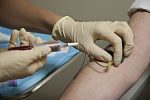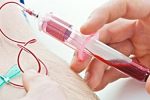If you’ve ever thought about becoming a phlebotomist, you can. The demand for phlebotomists is high. As the medical industry grows each year, more labs, hospitals, and pharmacies will need professionals to take the reigns to cope with the growing patient demand.
Choosing a career in healthcare can provide you with job security, a high annual salary, and advancement opportunities. While most states do not require you to complete an accredited program, individuals who have taken phlebotomy classes do enjoy better employment opportunities and a higher salary.
Obtaining certification is not mandatory in most states. However, this type of credential can help you to stand out from the competition. The training program you choose can affect the type of position you can qualify for after graduation.
Usually, you can find these programs available at community colleges, vocational schools, technical schools, and universities. Most training programs will result in a certificate of completion or a diploma. However, there are also associate’s degree programs available, but they’re not common.
What Is a Phlebotomist?
If you don’t already know what a phlebotomist is or what they do, don’t worry. Phlebotomists make incisions in veins and draw blood using a needle. While technically any medical practitioner who is trained in drawing blood from a patient can be considered trained in phlebotomy, there are specialized phlebotomists, which is where you come in. Qualified phlebotomists practice something known as venipuncture.
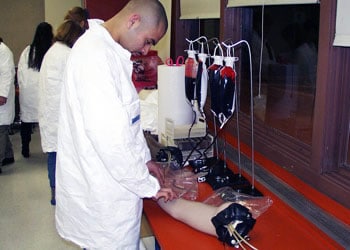
What Is Venipuncture?
Venipuncture is a procedure that involves drawing a small amount of blood from a patient for testing purposes. This is the main duty of the phlebotomist, and they can perform this procedure many times each day, depending on their place of employment.
For example, doctors might order a blood test to treat a patient and potentially diagnose a condition. Whether the procedure is performed at the doctor’s office or a special medical testing facility, the patient will likely be referred to a phlebotomist who can carry out the venipuncture.
After drawing however many blood samples the doctor may have ordered, the phlebotomist will label the blood sample and transport it to a lab where it will be tested, and the patient can be more accurately diagnosed.
Phlebotomists might also draw blood from a patient for purposes of blood donation, blood transfusions, or even for research. In many cases, a phlebotomist may even collect very small quantities of blood using fingersticks depending on the tests a patient needs to treat and diagnose specific conditions (such as HIV testing or glucose monitoring).
Other Duties of a Phlebotomist
Phlebotomists perform other duties as well. A phlebotomist may be in charge of preparing a patient, explaining procedures to patients, restoring hemostasis of puncture sites, delivering blood samples, and more. Not only will you need to be comfortable with drawing blood but you’ll want to have good people skills too.
You’ll be handling dozens of patients each day, many of whom may not be comfortable with needles or with having their blood drawn. A phlebotomist, in this sense, must also be able to help a patient understand why a test is necessary and ensure they’re receiving the most accurate test possible. If this sounds like something that’s right up your alley, read on to find out how you can become a phlebotomist.
Why You Should Become a Phlebotomist
Phlebotomists do a lot of good on a regular basis. You’re helping ensure that patients can be accurately diagnosed so they can receive the medical care they need and deserve while helping make sure that doctors and nurses can spend less time trying to obtain blood samples and more time ensuring they can spend time with their patients.
On average, phlebotomists earn about $15 USD an hour and earn an annual salary of $29,730 USD. In just about ten years, the field is expected to grow by about 27%, meaning that the demand has never been higher. If you’re interested in becoming a phlebotomist, it’s never been a better time to consider enrolling in a phlebotomist program and embarking on a new career as a phlebotomist.
Why Enroll in a Phlebotomy Course?
As we mentioned earlier, you don’t necessarily need certification to become a phlebotomist in most US states. In fact, only California, Washington, Nevada, and Louisiana require special licensing. To become a phlebotomist and in California, only a small handful of agencies offer national certification.
But this doesn’t mean that you shouldn’t consider certification in other states. The medical field is very, very competitive. Having certification and experience in the field shows that you’re serious about your career and will help you stand apart from the hoards of other applicants.
Plus, taking a phlebotomy course is a great way to ensure you’re truly ready to start a career in phlebotomy. If you’ve ever wanted to join the medical field but aren’t interested in pursuing a degree and career as a doctor or a nurse, a phlebotomist is a great way to get involved and explore your passion for helping out patients. By obtaining your certification to become a licensed phlebotomist, you’re ensuring that you are as experienced as you possibly can be to provide this important service to your patients.
Qualifying for Enrollment
To qualify for enrollment into a phlebotomy training program, you must be at least eighteen years of age and possess a high school diploma or a GED.
Some schools will also require the applicant to have up-to-date immunizations. If you’re not sure if you’re up-to-date on your vaccinations, ensure that you can find time to schedule your vaccinations before you enroll in school. Many programs will also require an applicant to pass a criminal background check and drug screening.
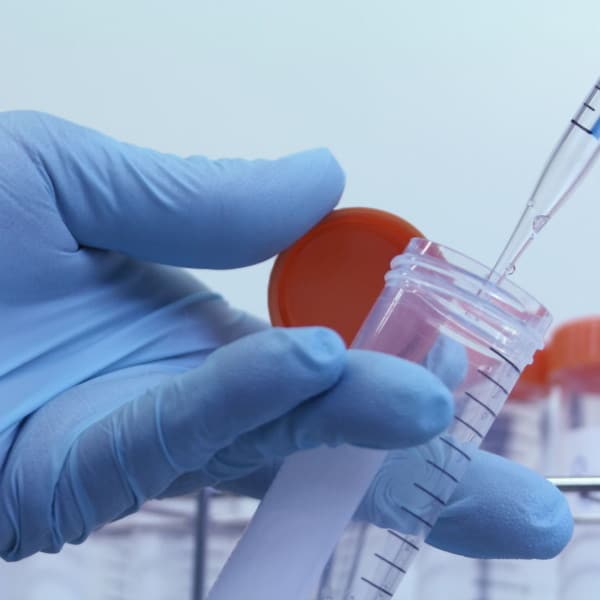
If it sounds like you fit the bill, you’re good to go. Make sure that you have a clean criminal record, a diploma/GED, and all your vaccinations up-to-date. You may be applying to multiple programs so it’s important you can meet the standards of each, so you don’t have to scramble last minute to make sure you qualify for enrollment at different schools. There are hundreds of colleges and institutions all over the country that offer phlebotomy training. Many community colleges, for instance, offer phlebotomy and general education classes.
Warning: Why Accreditation is Key in the Venipuncture Field
The length of time it takes to complete a phlebotomy program will depend on whether you go full or part-time, something you’ll want to think about before you consider enrollment in a phlebotomy program. It will also be based on how much time each week you can devote to clinical work.
Before enrolling, you should do some extensive research to determine if the school you’re interested in features a program that’s accredited. If a program is not accredited, then you will not be eligible to take the certification exam after graduation.
But what do we mean when we say a program is accredited? When a program is accredited, it means that the course material has been approved by a certifying agency. This is especially important if you live in a state that requires certification, such as California. Schools that advertise exclusively online programs for phlebotomy and courses offered by for-profit institutions such as the University of Phoenix are usually not accredited and should be avoided. Your best bet is to consider taking a phlebotomy course at a public or community college- more often than not, these courses tend to be accredited although you’ll still want to do research to make sure.
Classes and Clinical Training for the Phlebotomist
Training programs will include in-class training and clinical work in a real medical setting.
The in-class portion of a program can take up to six to twelve months to complete, or a minimum of forty credit hours. Some colleges offer phlebotomy courses that can take as little as two semesters to complete. But as we mentioned earlier, how long it takes you to complete a phlebotomy program can depend entirely on your school and your schedule. Tuition varies from program to program but on average, expect your total tuition to come to about $2,000, not including required textbooks. Financial aid and student loans are, of course, available with most programs if needed.
The curriculum of any phlebotomy program will cover subject matter including venipuncture procedures, medical ethics, patient interaction, specimen care, medical terminology and human anatomy. You’ll be trained on how to perform your expected duties as a phlebotomist and how to interact in various medical settings.
The in-class portion of the program also includes labs that allow students to practice simulated venipuncture procedures. These labs allow the student to work on mannequin arms and practice blood draw techniques. But part of a phlebotomy course also involves clinical, practical training. Let’s consider what that all involves. The classes are designed to prepare you for the clinical portion of the program, providing you with the skills and knowledge necessary to feel confident working with patients.
Clinical Training Classes
The clinical portion of the program will take place at a local hospital or clinic. Students will initially observe professional phlebotomists as they interact with patients and co-workers. To qualify for certification, a phlebotomy student will need to complete a hundred unaided venipuncture procedures. Most programs will also require you to perform a hundred unaided venipunctures for you to successfully graduate so get comfortable with the procedure.
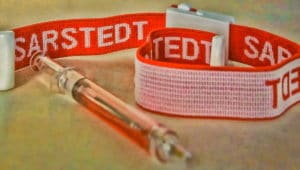
While working as a trainee in a medical facility, the phlebotomy student will work under the direct supervision of professional phlebotomists and facility staff. Typically, the clinical work portion consists of forty hours of practical training.
Most students will initially find the clinical work somewhat intimidating, however, by the final week, students will feel confident enough to complete venipunctures on their own. They will also learn about medical terminology, how to read physician’s orders and how to interact successfully with patients from a variety of backgrounds and explain the procedure step by step to them.
They’ll also become knowledgeable about insurance forms, how to safely handle and dispose of samples and how to correctly store and transport them. In other words, you’ll be well prepared for all aspects of a career as a phlebotomist. So don’t worry if it all seems like a lot to handle right now. You’ll do just fine.
Phlebotomy Certification & Exams
These classes will prepare you to take the certification exam. The exam typically consists of practical and written components. These exams are offered by dozens of licensing organizations around the country and are meant to test you on your knowledge of all aspects of phlebotomy.
Be sure to consider where you’re getting licensing. For example, California only recognizes licenses from six organizations. This is why it is vital to be fully aware of which organizations you are getting the license from
The Phlebotomy Career: Life after Graduation
After you graduate, you can find employment in some medical facilities, such as hospitals, clinics, private practices and federal labs. Working as a mobile phlebotomist is also a possibility and is ideal for individuals who enjoy traveling. These companies are usually privately owned and are contracted by medical facilities who do not employ phlebotomists, or hospices and home health agencies. Hospices and home health agencies will hire experienced and entry-level phlebotomists to provide care to a patient in their own home because they are unable to travel due to illness or injury.
Working in a larger medical facility, where some phlebotomists are on staff can provide you with opportunities for career advancements, for such positions as lead phlebotomy tech, supervisor or manager.
With all this in mind, it’s never been a better time to consider a career in phlebotomy. By taking a phlebotomy course and seeking accreditation, you’ll be well prepared for entering this highly competitive, rewarding field. Your career in phlebotomy awaits. So why wait any longer? Start applying today.



